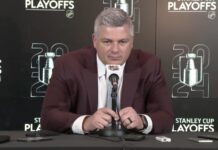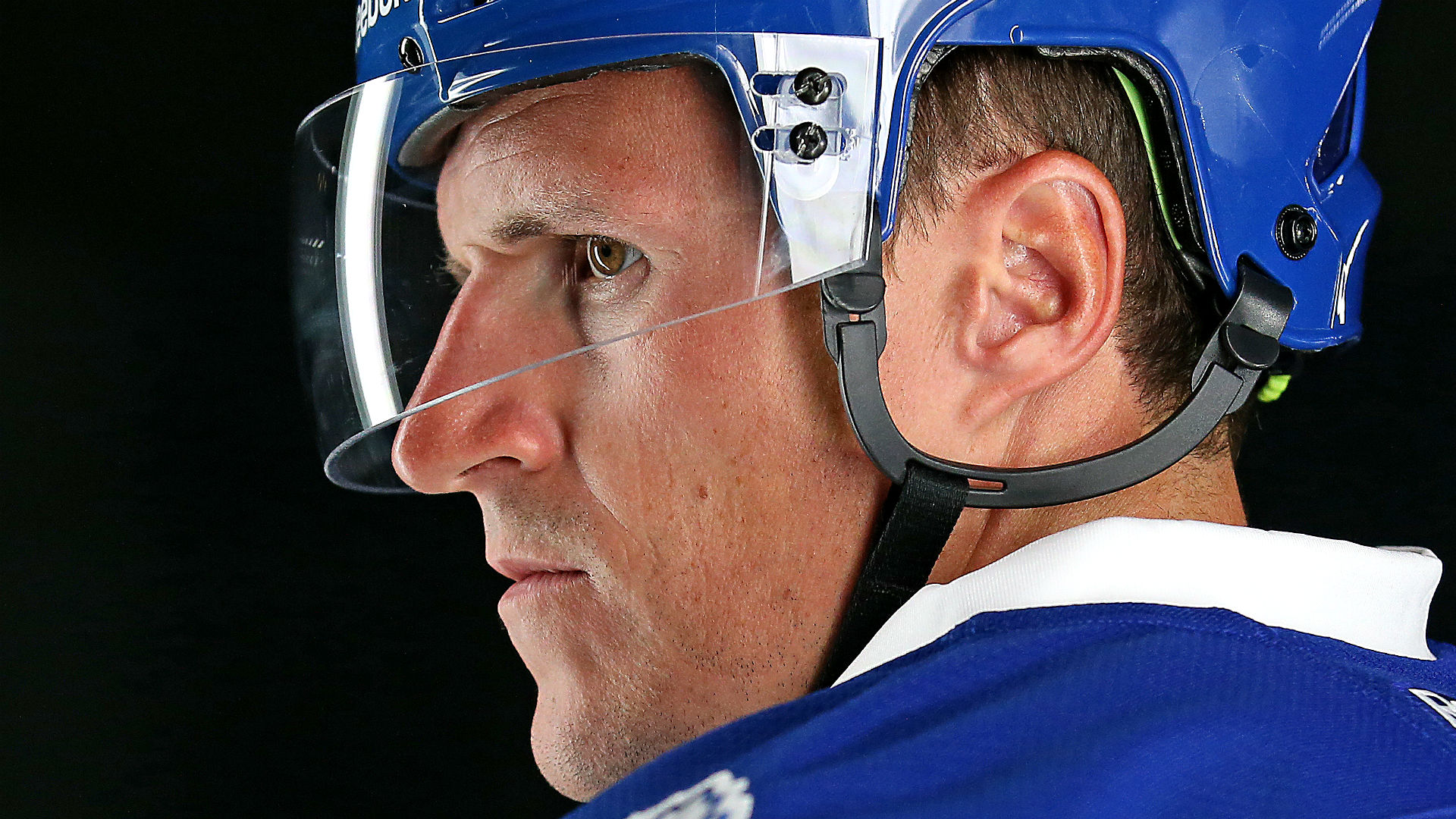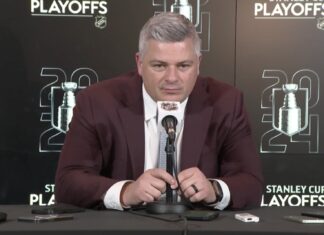When the 2015-16 season is all set and done, the results are going to show that it was nearly identical to 2014-15.
That’s as far as the comparison goes.
The 2014-15 campaign was filled with controversies to the point where every week became a soap opera episode. The team was bad on the ice, and even worse off of it. The mood around the Toronto Maple Leafs was smothered by a dark cloud swirling with negativity. Their players were perceived negatively throughout the league.
Fast forward over half a season and the team results are the same, only with a completely different feeling. The off-ice distractions have largely gone away. There is a semblance of structure and accountability on the ice.
Expectations were lowered and have stayed low, and the player value is slowly being built back up. Tuesday’s Dion Phaneuf trade is a great example.
There was interest in Phaneuf last year, but only if the Leafs retained money to lower his cap hit. A year later, they not only traded him without taking on a single bad long-term contract or any retention on Phaneuf’s contract, they grabbed a decent prospect and a draft pick in the process.
It cannot be stressed enough how significant it is that the organization did not have to retain money on Phaneuf’s massive contract. The value is not only in the saved dollars, but the flexibility that allows them to eat salary moving forward. Each team is only allowed to retain salary on a given contract three times per season. With the Kessel contract being one of those three for the next six seasons, adding in Phaneuf’s contract would have meant the Leafs would only have one remaining slot to retain money with for the next five seasons — significantly handicapping the flexibility and creativity of one of the richest teams in the NHL.
A big reason why the Leafs were able to get a reasonably favourable deal is all the work they put into inflating his on-ice value.
Phaneuf led the Leafs in overall power play (PP) time by nearly 20 minutes and was tied for seventh on the team in PP points. He doesn’t have a single PP goal. The Leafs’ PP breakout is built around having a quarterback skate the puck up ice and enter the zone with speed, and yet Phaneuf played over Gardiner and Rielly in that spot. That led to seven PP assists for Dion, helping push his point totals to 24 in 51 games, which isn’t too bad when you first look at it.
Shorthanded, he was eighth on the team in ice time. The last three seasons he was second, third and second respectively. This kept him fresher to focus on the things that would help his value such as scoring. After weighing him down with too big of an all-situations workload year over year in Toronto, the coaching staff wasn’t asking the world of him this season.
At even strength, Phaneuf played on the second pairing away from top lines all season. He played with Jake Gardiner, a top four defenseman in his prime, and benefitted immensely from it:
https://twitter.com/JonathanWillis/status/697086232577384448
The Leafs pumped his value in every way they possibly could have. Just like how Tyler Bozak and Pierre Parenteau receive heavy doses of offensive zone starts and powerplay time, or how Michael Grabner plays on the top line despite Roman Polak having more points than him so far this season.
The deal itself is pretty simple; as Mirtle outlines, it is a money deal. The Leafs are still at least another season away from being competitive. By the time they are (presumably) good, Dion Phaneuf will be (presumably) even worse, and his $7 million cap hit can be used for bigger and better things.
This article from The6thSens looks at the other side of the deal, which looks about right from this side:
I believe that acquiring a contract of this magnitude when you’re a budget team and the player is on the wrong side of 30 is absolutely reckless. When the limitlessly budgeted Toronto Maple Leafs are trying to get out from under a player’s contract and refuse to eat any of his salary, that should tell you something…
But maybe when you’re Bryan Murray and you’re contemplating retirement, you don’t give two shits. You’ll continue to overpay for past production and chase name players whose best years are behind them because you won’t be the GM in a few years who’ll have to foot the bill.
Having to stomach receiving and playing overpaid, borderline NHLers that can’t stay healthy for a single season is a small price to pay for the Leafs. If you want more details on what else the Leafs gave up and got in return, Alec has the run down here. The only thing he didn’t mention, which he later deftly pointed out to me, was that the Leafs finally found their “Andy Wozniewski replacement.” The possibility of a Jared Cowen buyout adds even more value to the deal, although I am sure he will get every opportunity to stick with the team for next season.
There are really three things of value here. The first is the aforementioned money and avoiding retaining money.
The second value is an opportunity to turn over the defense in its entirety to Morgan Rielly and Jake Gardiner.
Matt Hunwick and Jared Cowen are under contract for next season, while Frank Corrado, Martin Marincin, Scott Harrington and Stuart Percy (as well as Morgan Rielly) are all RFAs. There are some serviceable players in that mix, but nobody that can really challenge Rielly or Gardiner’s ice time. Phaneuf played just 18 seconds less than Rielly and over two minutes more than Gardiner per game. He took PP time from both of them.
That $7 million hurdle is no longer around.
The third value comes in pushing the tank along. As bad as the Leafs have been since the lockout, they still haven’t completely bottomed out in the draft. Their first picks in each draft since the full season lockout are as follows:
| Draft Year | First Draft Pick | Player |
|---|---|---|
| 2015 | #4 | Mitch Marner |
| 2014 | #8 | William Nylander |
| 2013 | #21 | Frederick Gauthier |
| 2012 | #5 | Morgan Rielly |
| 2011 | #22 | Tyler Biggs |
| 2010 | #43 | Brad Ross |
| 2009 | #7 | Nazem Kadri |
| 2008 | #5 | Luke Schenn |
| 2007 | #74 | Dale Mitchell |
| 2006 | #13 | Jiri Tlusty |
In summary: Some nice selections, some disasters, and some picks recently that would probably go higher if you did over those drafts right now (looking at you, 2014 and 2012).
As Scott Cullen outlined in an article on draft pick value, the drop off in value between the first two picks and the third pick in the entry draft is substantial. There is another drop between third and fourth, and another drop once you’re out of the top five altogether. The Leafs have yet to completely bottom out.
The 2016 draft is looking like another stellar crop. There is a deep top 10 loaded with talent, but the top three players are distinguishable (Auston Matthews, Patrick Laine, Jesse Puljujarvi; you can make a case for Matthew Tkachuk too, though).
Between William Nylander, Mitch Marner, Connor Brown, Kasperi Kapanen and a few others, the Leafs have put together a strong prospect stable. The hope is to add one more high-end pick to put things over the top before beginning to integrate all of their youth into the NHL roster, instead of having them embarrass the AHL while the big club toils hopelessly.
The element of risk for Toronto in this trade is slim to none. Save for Dion Phaneuf becoming Larry Murphy 2.0, there is no real downside to the Leafs taking on some bad contracts for a single season. Even if the prospect and pick ultimately become nothing, the value is in clearing the $7 million salary long-term with no strings attached.
Taking on the contracts of Milan Michalek and Colin Greening gives the Leafs seven forwards signed for next season (Michalek, Greening, Bozak, Daniel Winnik, Leo Komarov, James van Riemsdyk and Joffrey Lupul). They have three noteworthy RFAs to decide on in Nazem Kadri, Peter Holland and Josh Leivo as well.
Leading up to the deadline, the big question will be whether they can unload Joffrey Lupul somehow, or even Tyler Bozak. That will clear more cap space and room for prospects, or players brought in otherwise.
In the meantime, as Mike Babcock promised, there will be more pain ahead.
As the old saying goes, the night is darkest before the dawn.


































